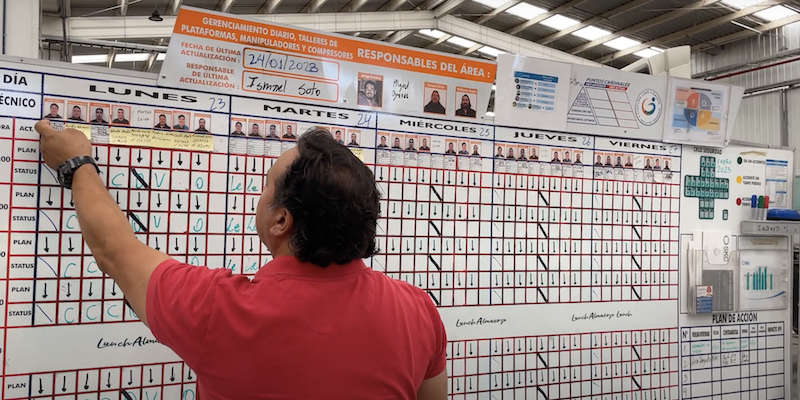
Project management woes
FEATURE – What are the main problems people encounter when running a project? The author ran a survey with 126 people over two years and presents the results of his research in this article.
Words: Severino Abad, Lean Coach, Instituto Lean Management – Spain
At this point, we all know that lean thinking can be applied to any environment and not just in automotive. We now have successful applications of lean in healthcare, hospitality, retail, higher education, banking, mining, agriculture, construction – to name but a few. Planet Lean itself has featured many of them over the past six years. These cases are noteworthy not just for the results achieved, but also for the approach adopted to reach them.
To try and help those who are interested in kicking off a lean transformation in project management, an area that’s currently on everybody’s lips and presents a number of distinctive features, I’d like to share the results of a little experiment I have run for the past two years. It aims to identify the most common problems preventing us from carrying out a project as initially planned.
Participating in this experiment were 126 people, whose professional profiles can be described as Project Manager or Project Leader. They work in different sectors:

These people were not selected randomly for statistical purposes. Instead, their answers were chosen afterwards, once they had answered a survey. I am not claiming to be establishing a knowledge base on Project management; I only want to share my learning, which I have often found useful in my work as a coach.
The methodology I have used was based on an assisted survey questionnaire, whose most relevant question in the context we are discussing in this article was:
“What were the three main problems you had to face in the last three projects you have participated in?”
My hope was that this question would transport me to a gemba that is often difficult to explore for different reasons:
- Time – processes that typically last a long time, in the order of weeks or months.
- Space – the gemba is large, spread across different locations or countries or, in some cases, is not an actual place.
I put a limit to three problems so that respondents could focus on the problems that really creates difficulties in the management of the project. The three-projects limit aimed to obtain answers focusing on recent facts and prevent people from bringing up those catastrophic events that we have all experienced at least once (they are easy to remember, but not representative of our every-day lives). I should mention that I never asked people to provide proof of the truthfulness of their answers. People were informed of my data-gathering activity (which they welcomed) and, as participants, they received feedback once I finished my work.
Here’s what I found:

UNDEFINED REQUIREMENTS
It’s curious to see that the biggest problem people mentioned – around one quarter of the respondents – is connected with the first principle of lean thinking: specifying value. How can we embark on a complex project without really knowing what we want to accomplish?
LACK OF COMMUNICATION
Under this “declaration” (or sentence) lie different interpretations depending on the person questioned. Despite this, there is an aspect common to many of the answers: the very tangible presence of “silo management”. This answer is more frequent in cases where the business the respondent belongs to has more than one office or facility. On the other hand, lack of communication creates a number of situations that are greatly detrimental to the normal development of a project. It makes it harder to detect potential mistakes and often leads to conflict.
Indeed, many of the respondents recognized they often applied the idea that “if you want something done well, you should do it yourself” – which makes it difficult to establish teamwork, an essential element in any project.
TIME CONSTRAINTS
One every 10 respondents complained that the timeframe in which the project had to be completed was insufficient given the available resources. Most of them admit that a speedy delivery time is often a non-negotiable requirement, but at the same time report that they have not received the support from management necessary to face up to the challenges inherent to the project (even when they had notified the Steering Committee at project kick-off).
UNCLEAR ROLES
Several people and entities participate in the execution of a project, each carrying out the tasks assigned to them during the planning and definition phases. This answer exposes two common problems:
- On the one hand, there are no specific individuals recognized as responsible for tasks and deliverables.
- Not defining roles means that the responsibility now falls onto the people executing the different tasks making up the project.
In any case, this generates uncertainty over who to go to in case help is necessary or an important decision must be made. Another consequence of this situation is interruptions, which are identified as cause number 6 in this survey.
If roles aren’t clearly defined and properly assigned, who has the responsibility to ensure that tasks are actually completed? In such a scenario, how can we hope to achieve the engagement of everyone involved? How can we facilitate the personal development of each team member if they don’t feel ownership of their work?
CHANGES IN REQUIREMENTS
This is one of the warhorse issues of any Project Manager. It can have a huge impact on the project and is in entirely in the hands of the customer.

It’s important to note that some of the respondents – from different sectors – think that the only way to face this problem is to reduce the project lead-time as much as possible, in order to “not give the client the time to make changes”. At the same time, they admit that with more engagement from all team members at the start of the project, many of the changes could have been avoided.
INTERRUPTIONS
Interruptions during the execution of a project can stem from:
- The multitasking we are typically subject to, which is not necessarily a problem in and of itself. The issue appears when unexpected and unplanned tasks appear suddenly, which need to take priority over the ones that are planned. This leads to a several instances in which the person responsible for the different takes has to repeatedly switch from one to another.
- The internal organization of the work. Based on the degree of organization, the execution of tasks can be carried out in an orderly way or not.
- Company-level organizational flaws, including the lack of a clear definition of roles and responsibilities (which makes the person who answers a call or email the go-to individual to solve a problem, whether or not he/she is the person in charge of a task), mass emailing (which copies in people who don’t need to be part of a conversation), calling many or unnecessary meetings, or a controlling system (in the form of excessive reporting, for example) in the hope to ensure completion of the project. As stated by the Law of homogeneous sequences, “a task completed in one single stretch will actually be completed much faster than doing that same task in multiple attempts or multiple goals”.
- Unclear roles. Too often, not knowing who is responsible for what results in actions not being carried out, which leads to finger-pointing and internal wars.
KNOWLEDGE/FEEDBACK MANAGEMENT
The absence of knowledge and feedback management, through which we detect, choose, classify, disseminate and transfer information and learning stemming from the project execution, leads to the recurrence of problems and the squandering of resources we need to execute the project. This is because those resources have to be re-invested to reach the same learnings we had previously obtained but failed to properly record. Furthermore, not being able to change the feedback we receive from different players during a project will make it more likely for the same errors to appear again in future undertakings.
OUTSOURCING
This problem is very much related to the one we just outlined. Outsourcing parts of a project is very common, especially for those requiring certain technological tools or in businesses that are reluctant to take on fixed structural costs. In any case, what this effectively means is to put the ecosystem of a project in the hands of people who often don’t know the modus operandi of the organization.
Effective communicating with contractors and obtaining their full engagement seems to be a common problem among Project Managers. Their biggest ‘complaint’ refers to the difficulty of instilling in subcontractors the empathy necessary to understand the customer of the project and their behaviors.
LACK OF METHODOLOGY
It was very interesting to see how respondents who had recently gone through a course on Project Management – be it PMBOK, Agile, Scrum, etc – listed ‘absence of a methodology’ as one of the Top 3 causes of problems in project management. In my opinion, following conversations I have had with respondents, this cause seems to be more an excuse than anything else. What I was able to see was that the presence of certain people in the project team could lead to a high likelihood of problems, typically related to the coordination of tasks or the distribution of clear and specific roles and responsibilities. This is due to a tendency of many individuals to carry out projects ‘their own way’. In essence, it’s not that there is no methodology; it’s that everyone has and uses their own.
Another negative consequence of this is the poor level of teamwork that generally exists in many firms. Unfortunately, most of us still work in environments in which different functions don’t communicate (solo thinking) or, when they do, fight and blame each other.
UNDEFINED KEY POINTS
Over the course of a project, problems are bound to occur. This issue highlighted in the survey refers to the different opinions different team members have about what’s essential to the project and what is merely ancillary. This means that, faced with an anomaly, different players will react in different ways; this, in turn, can lead to big inconsistencies when the time comes to deal with variation across different parts of the process. If we don’t clarify what the project aims to achieve and what its essential components are, how are we going to leverage the synergies we require in order to complete it successfully?
NUMEROUS STAKEHOLDERS
A high number of players will naturally influence a project, which makes it critical to establish robust and agile forms of communication to facilitate consensus. A common problem here is that it is actually unclear who the stakeholders are: the impact that changes in the project and decisions can have on them is very big, and we often don’t even know.
The respondents to the survey added that there are often power struggles between different stakeholders (especially internally to an organization), forcing the team to work on the project in a hostile environment.
RISK MANAGEMENT
A risk is a potential event or uncertain condition that, if it were to materialize, would negatively impact the outcome of the project. Unfortunately, the fact that such event is uncertain means we often don’t pay enough attention to it.
Risks are inherent to any project and are a natural part of life. They are always lurking (as Murphy’s Law has taught each and every one time and time again). Denying their existance is pure “wishful thinking”, to cite Allan C. Ward and Durwan K. Sobek II in their book Lean Product and Process Development. The early identification of risks, the introduction of a monitoring mechanism and alerting system, and the establishment of clear processes we can follow in the event of a problem actually occurring go a long way ensuring we can minimize its impact and, at the same time, increase the level of knowledge of the project team. Not to mention the sense of security a team feels when they are aware of the risks a project faces and the positive impact this has on their state of mind!
FOLLOW-UP
Detecting deviation or anomalies in the execution of a project as early as possible will provide us with the reactivity necessary to take quick corrective action. In this sense, a follow-up system will allow us to identify problems as soon as they appear and avoid stressing the system as we try to regain control of the situation. Being able to monitor and track the situation at all times will help us make the most of our gains and boost morale in our team.
---
If you want to learn about one of the most effective tools at our disposal to fight the problems identified in this survey – and others we may not have identified yet – look no further than the obeya (Roberto Priolo recently published a good article on it here on Planet Lean). It’s also fantastic in helping us to develop the capabilities of our team.
THE AUTHOR

Read more


FEATURE – As the senseless war in Ukraine continues, the author looks back to his visit to the country in 2017, recalling and celebrating its vibrant lean community.


FEATURE – Lean provides everyone with a framework to learn continuously and do an ever-better job. Without this understanding, an executive will not be able to steer the organization in the right direction.


FEATURE – As Italy rolls out its vaccination campaign, the author reflects on what he recently observed at a vaccination hub in the Veneto region and discusses how the process could be made leaner.


FEATURE – The author explores how SKC embraced Lean Thinking as a cultural shift – one that empowers people, transforms leadership, and shows how true sustainability starts with human growth.

